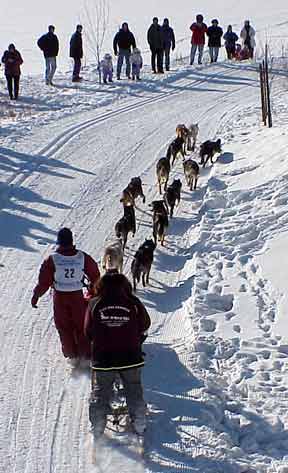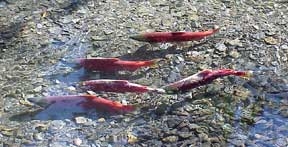|

Alaska Events
One of Alaska's biggest events takes place in the winter: the Iditarod,
the 1,100-mile sled dog race from Anchorage to Nome that is held each
March. Eighty-one mushers set out on March 5 for the 2000 race, making
it the biggest field ever up to that time. Sixty-eight of them completed
the race, with the winner, Doug Swingley, doing it in 9 days and 58
minutes. The last musher reached Nome on March 20. Sixty-four mushers
began the 2002 race, which Martin Buser won in 8 days, 22 hours and 46 minutes. His time was a record, but it fell in 2011 when John Baker finished three hours earlier. Eighty-two mushers competed in the
2007 race. One hundred eleven signed up for the 2008 race, but the number was down to 95 -- still a record -- on the Sunday when the serious racing began.
The race begins on a Saturday in early March in downtown Anchorage.
The mushers start on Fourth Avenue. The first part of the race is
on streets that have been covered with snow for the event, and then
the teams move onto trails that wind through the city and out into
the country.
The first day's race attracts crowds, but it is a ceremonial event.
The real racing starts on Sunday after a restart in Willow, just north of Wasilla and about 60 miles east of Anchorage. (Until recently, the restart was held in Wasilla, known as Home of the Iditarod. Development in that area has made conditions for mushing there less favorable than in Willow.) During the next week-and-a-half
the teams cross a thousand miles of wilderness on their way to Nome
on Alaska's northwest coast.
While the Iditarod is Alaska's biggest winter event, there are several
others including the Anchorage Fur Rendezvous, Talkeetna's Winter
Fest with its Wilderness Woman competition and Seward's Polar Bear
Jump Off Festival (these are described a little more fully on the
Talkeetna and Seward
pages). The weeklong Fur Rendezvous is held in February and includes
a snow sculpture contest, sled dog races, a parade, fireworks and
a carnival. Since 2008 the Fur Rendezvous in late February and the first days of March has included a reindeer run -- in 2008 it involved about 40 reindeer and 500 people -- down Fourth Avenue in downtown Anchorage and a hot air balloon event.
 The
highlight of Seward's weekend festival in mid-January is the Polar
Bear Plunge: Folks dress up in outlandish costumes and dive into Seward's
Harbor. Seward is the northernmost icefree seaport in North America,
but the water isn't much above freezing. The
highlight of Seward's weekend festival in mid-January is the Polar
Bear Plunge: Folks dress up in outlandish costumes and dive into Seward's
Harbor. Seward is the northernmost icefree seaport in North America,
but the water isn't much above freezing.
Winter events help Alaskans fight off cabin fever. That's not a problem
in the summer, but there are plenty of summer events, too, such as
summer solstice celebrations, the Halibut derby in Homer, Seward's
July Fourth Mount Marathon race (perhaps the bloodiest race in America,
as racers sometimes lose their footing in their efforts to be the
fastest to get up and down the 3,000-foot mountain) and its Silver
Salmon Derby -- there's even a salmon derby at Ship Creek, in the
shadow of downtown Anchorage.
As summer ends, there's the Alaska State Fair in Palmer, about 50
miles east of Anchorage. Recommended attractions at the fair are the
giant cabbages -- the 1999 winner weighed 91 pounds -- and the handicrafts,
including quilts and stained glass with Alaska themes.

Salmon move through the shallows of a stream near
Seward.
|
|
|

 The
highlight of Seward's weekend festival in mid-January is the Polar
Bear Plunge: Folks dress up in outlandish costumes and dive into Seward's
Harbor. Seward is the northernmost icefree seaport in North America,
but the water isn't much above freezing.
The
highlight of Seward's weekend festival in mid-January is the Polar
Bear Plunge: Folks dress up in outlandish costumes and dive into Seward's
Harbor. Seward is the northernmost icefree seaport in North America,
but the water isn't much above freezing.